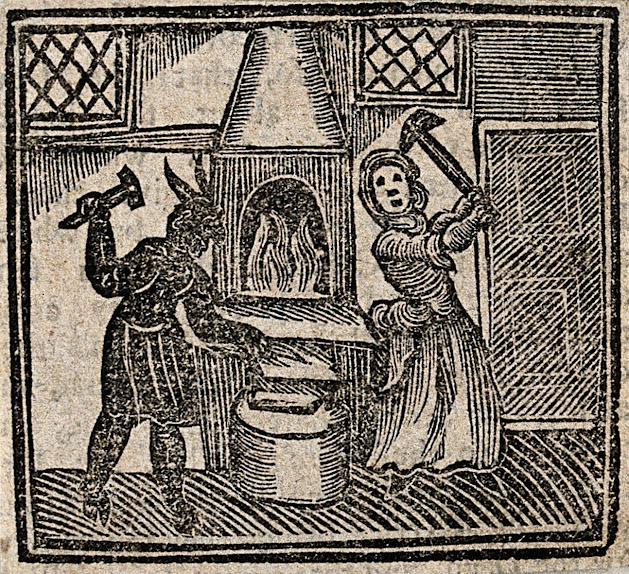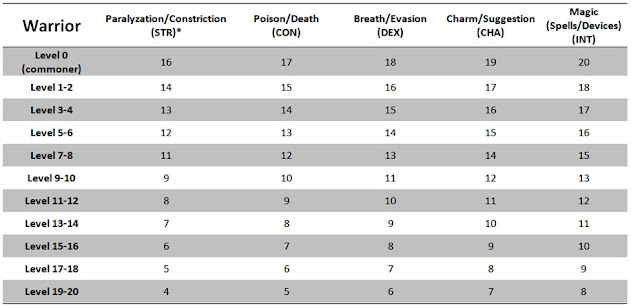Introduction
This post’s content is nothing if not a bit too obvious, dealing with my personal adaptations of the AD&D core into something more palatable. There is a lot of arcane stuff down there that were questionable ideas right from day one, others that simply have not aged well. This much would be true for any given edition of any given game but I’ll try not to dwell on what that means.
In a bid not to reinvent the wheel, I embrace a lot of conceptual frameworks which I had long regarded with mistrust (all the way since hurriedly leafing through ‘em on the old Inquest magazine back when M:tG was the belle du jour and RPGs were relegated to a lower rung of uncoolness).
Whereas once my eyes glazed at the sight of these progression tables, things were quickly demystified through use, as I came to realize they do not involve any looking up whatsoever to the average player, as only a single line of information is transcribed to the character sheet, remaining constant until the point of levelling is reached.
The aggregation of classes by archetype was something that struck me as making a lot of sense, bringing design clarity and a shared foundation for ease of later adjustment and differentiation by class. Individualized weapon proficiencies and penalties for lack thereof are also coopted without a whimper, as are the HD per archetype (d4 for casters and CON adjustments ceasing at ~9th level). The 2nd Edition Attack Bonuses, these I felt had to be reined in somewhat, as I do give some credence to the value of narrower variance – the oft talked bounded accuracy. In this I tried to be solomonic, keeping a fairly discernible progression for the more martial classes without going overboard (and cheated just a tad with the rogue – appropriate, if anything). I resisted for the longest time to the concept of having a single table determine monster attack bonuses, feeling it to be simplistic to the extreme; until I started reading past the gloss of the more modern monster manuals to find that, under the guise of more numbers, it amounted to about the same. Not to wax overlong on the merits of each, suffice to say that I’m willing to try it. In a world of off-the-cuff encounters and absent the safety net of challenge ratings, the virtues of immediacy and transparency afforded by a simple table come as precious to an improvising referee.
Saving Throws see the greatest change, being recast into something more intuitive to the undiscerning eye while keeping their functionality and overall progression, as it was felt the classic save names required habituation for little gain. I also rejiggered the categories, preferring to have a dedicated column for saving throws against Charm effects and ditching the practically redundant “Rod/Staff/Wands” category, perfectly duplicable by inserting save modifiers in a magic item’s description to account for their being weaker than a caster. I am tentatively declaring each save to be adjustable by the attribute modifiers, going with the corresponding obvious choices and having Wisdom modify all of the non-magic saves, meaning all columns except the rightmost.
Class Archetypes
A character’s class is a calling unto itself, one into which the character has poured all of his formative years, be it formally or informally, to make the grade of level one, laying the notion of backgrounds diverse from those directly relating to the essence of the class at the very edge of the table.
Rather than collections of battle powers, the best classes are those which offer a distillation of function, one whose purpose is clearly defined. The classic three (or four) classes are those that lie closest to their archetypical foundation. Next come those secondary classes which, though arguably not essential, rank high on strength of thematic concept, such as bards, rangers and druids for the standard fantasy backdrop. Lastly comes everything else, from the derivative to the scatological, classes who either offer a venue of window-dressing for the setting or constitute pure indulgence. Regardless, they all conform to the following division into four archetypes, from which they may then depart slightly:
· Warriors
o Attack bonus progression: +2 every 3 levels
o d10 HD (+3 hp/level after level 9)
o Weapon Proficiencies: 4 (+1 every 3 levels)
o Penalty for lack of Weapon Proficiency: -2
o Saving Throw Progression: every 2 levels
· Priests
o Attack bonus progression: every 2 levels
o d8 HD (+2 hp/level after level 9)
o Weapon Proficiencies: 2 (+1 every 4 levels)
o Penalty for Lack of Weapon Proficiency: -4
o Saving Throw Progression: every 3 levels
· Rogues
o Attack bonus progression: every 3 levels
o d6 HD (+2 hp/level after level 9)
o Weapon Proficiencies: 3 (+1 every 4 levels)
o Penalty for Lack of Weapon Proficiency: -3
o Saving Throw Progression: every 4 levels
· Spellcasters
o Attack bonus progression: every 4 levels
o d4 HD (+1 hp/level after level 9)
o Weapon Proficiencies: 1 (+1 every 6 levels)
o Penalty for Lack of Weapon Proficiency: -5
o Saving Throw Progression: every 5 levels
Attack Bonus Progression Tables
Saving
Throw Progression Tables







Sem comentários:
Enviar um comentário